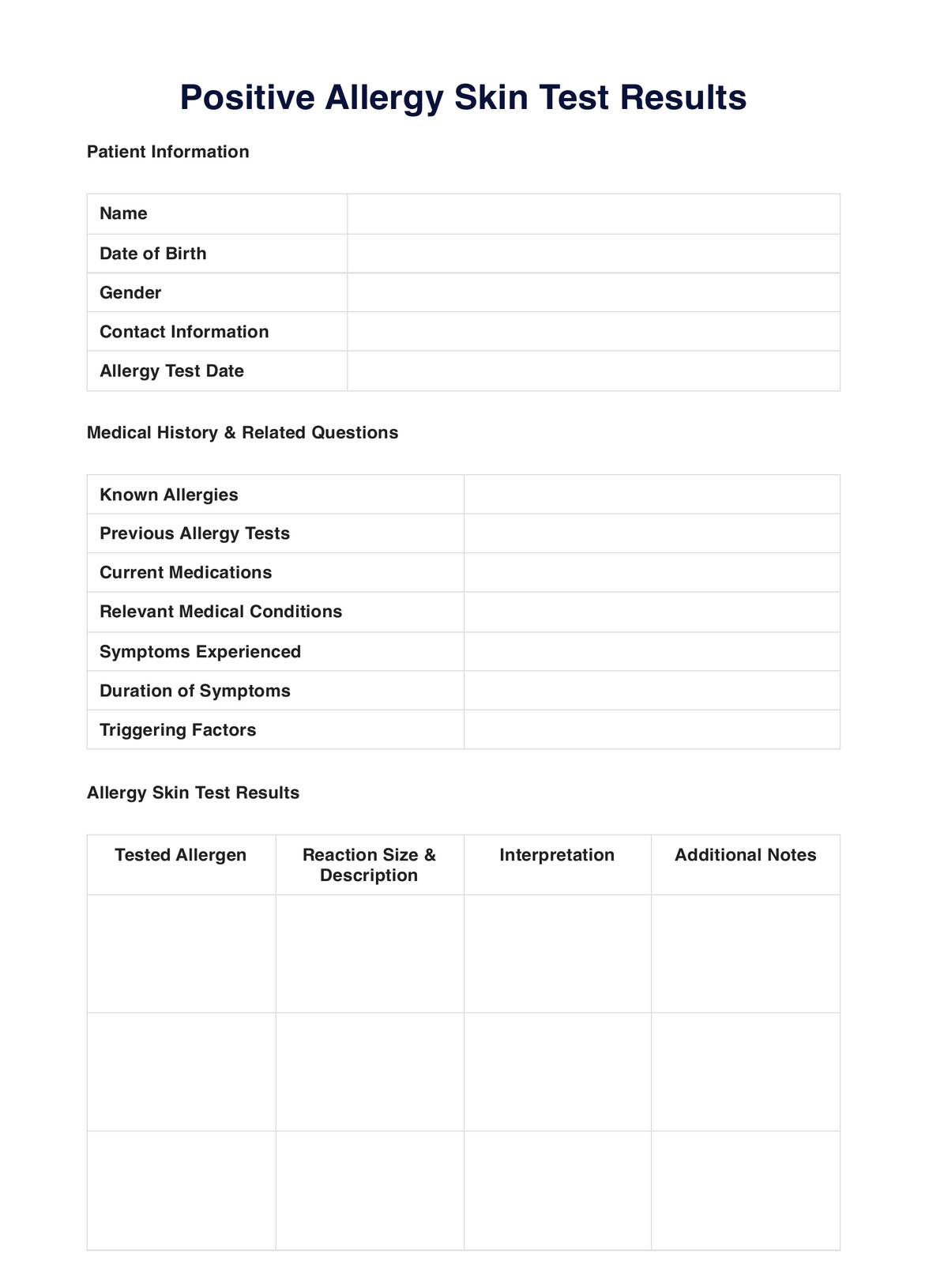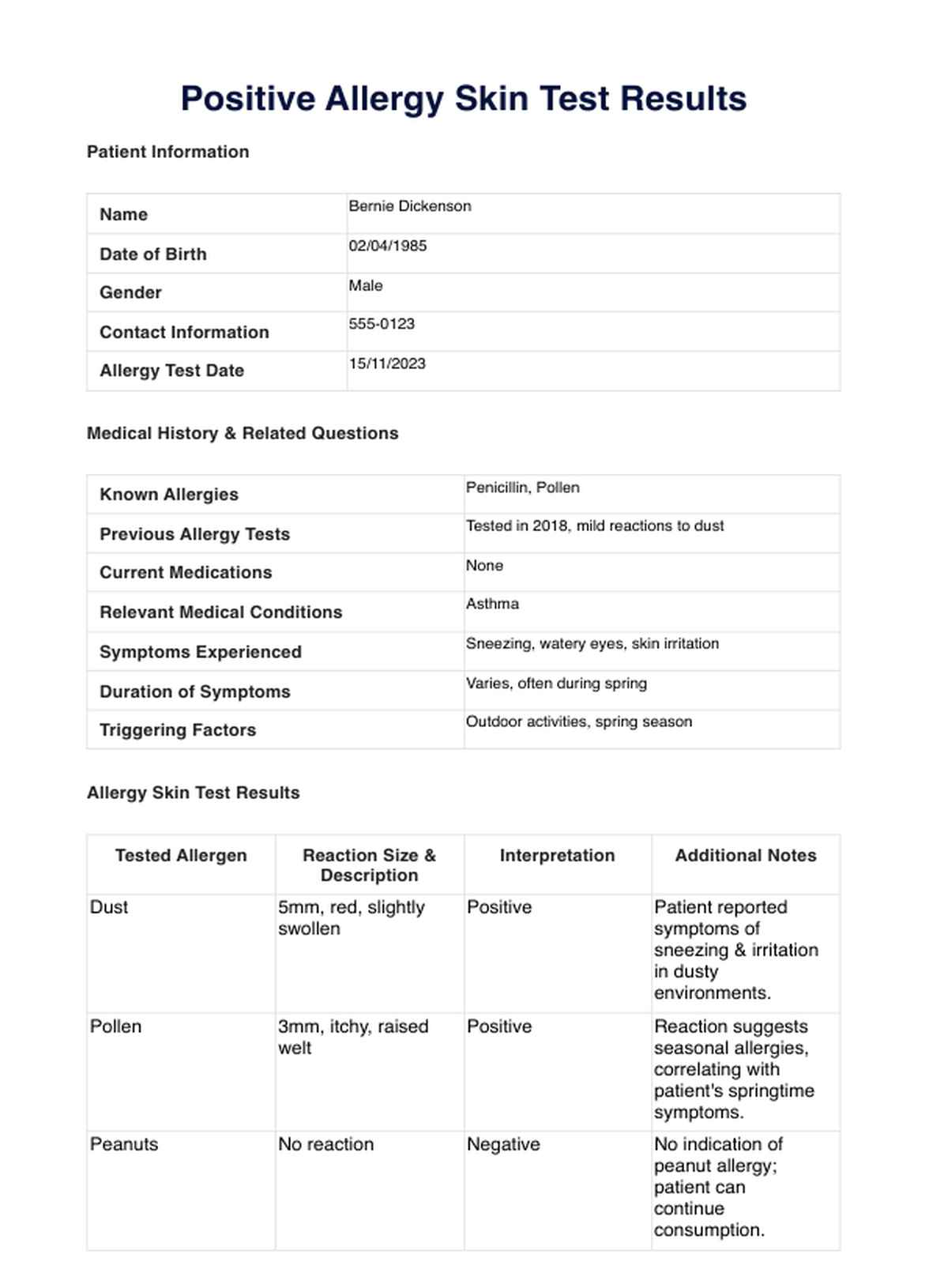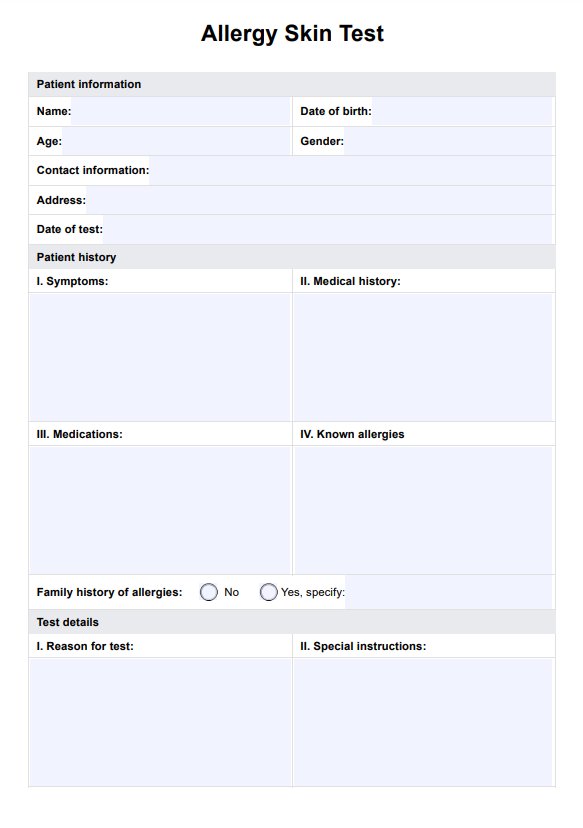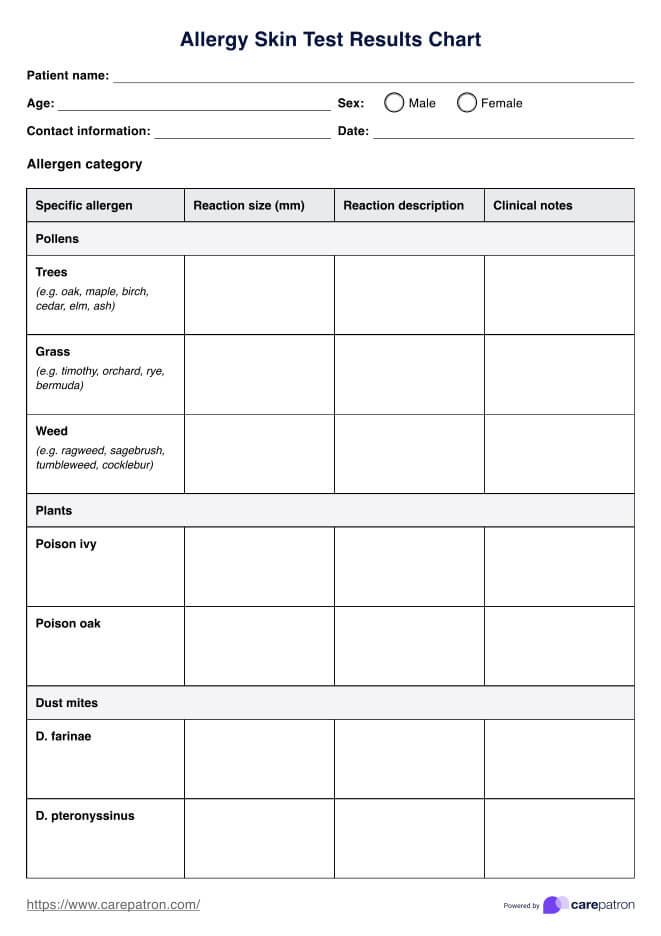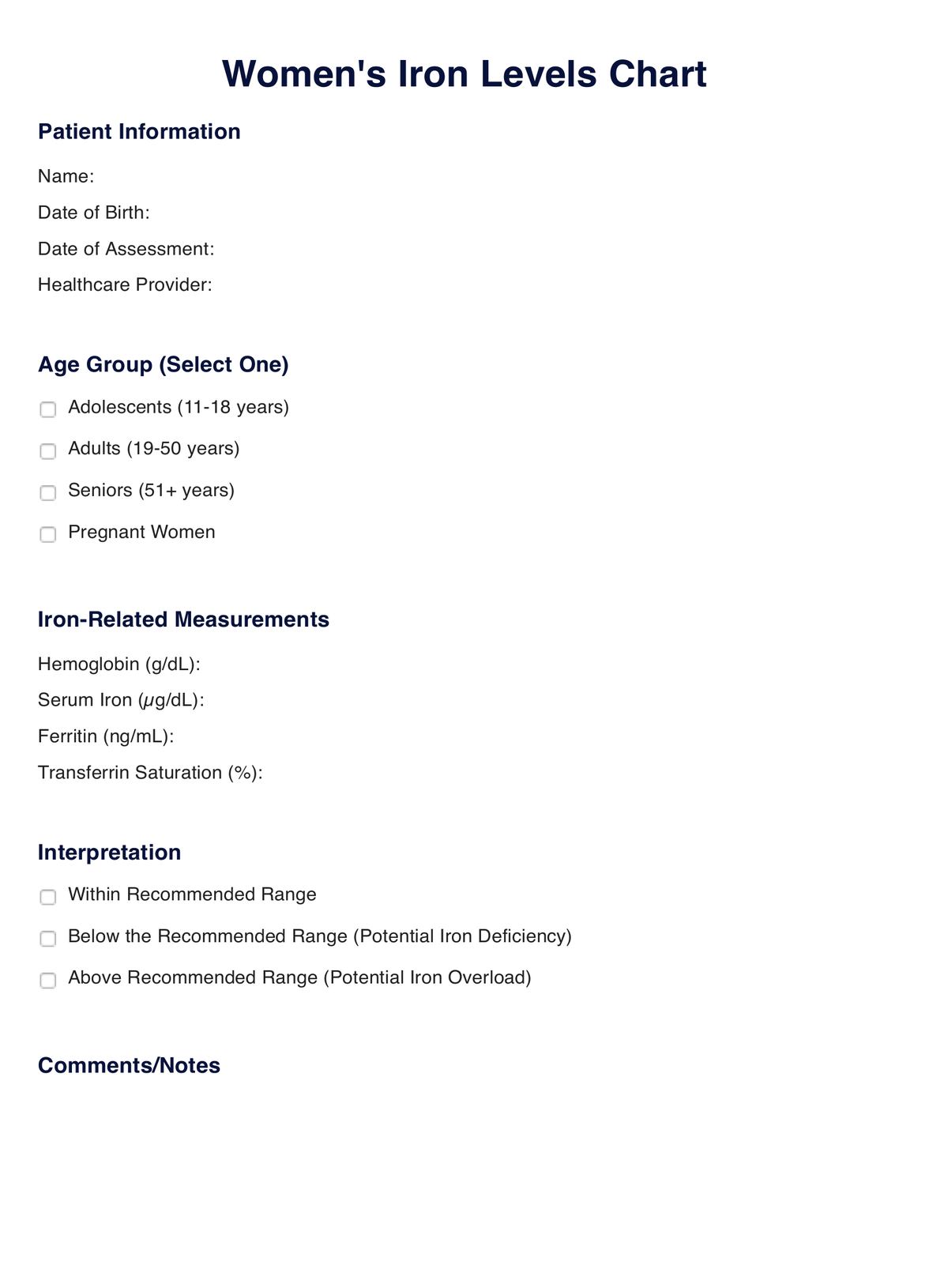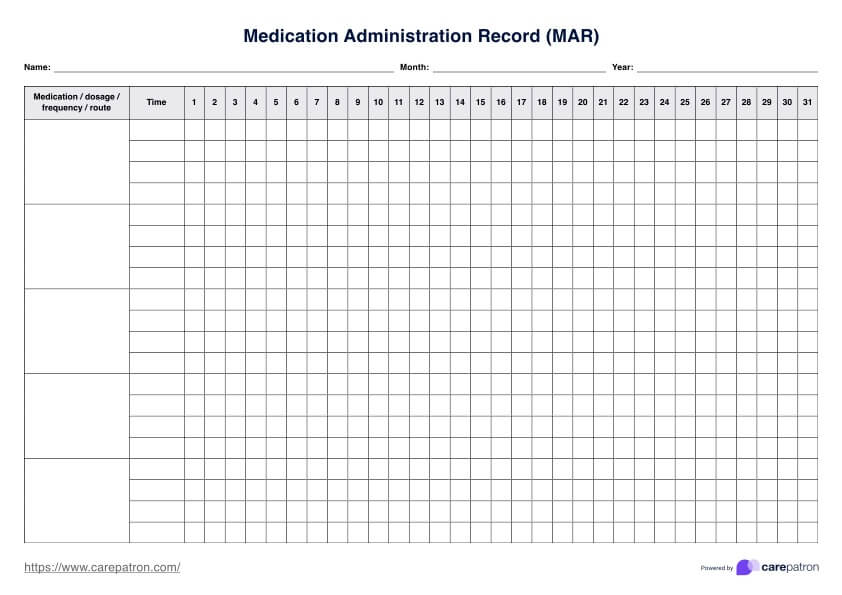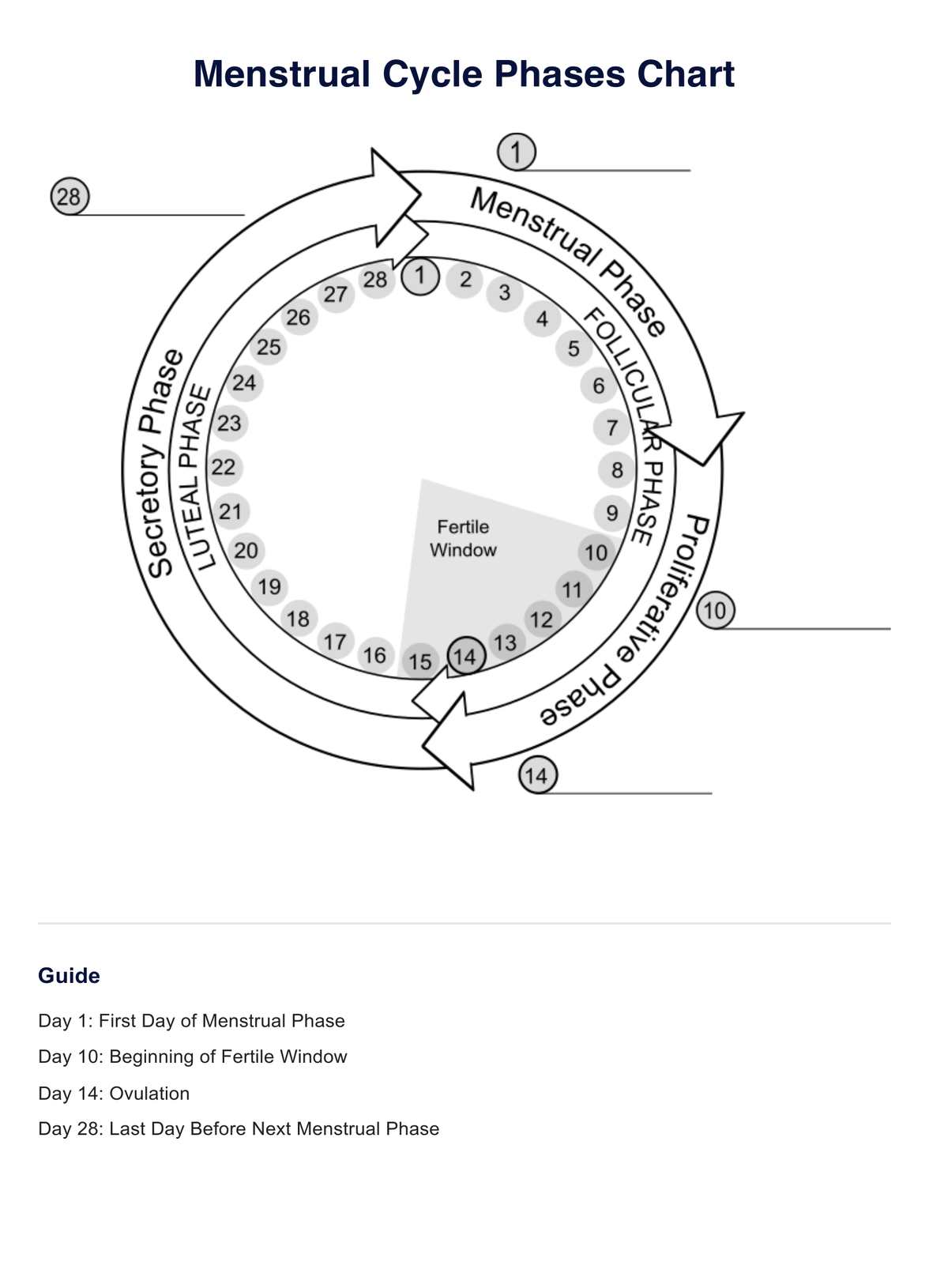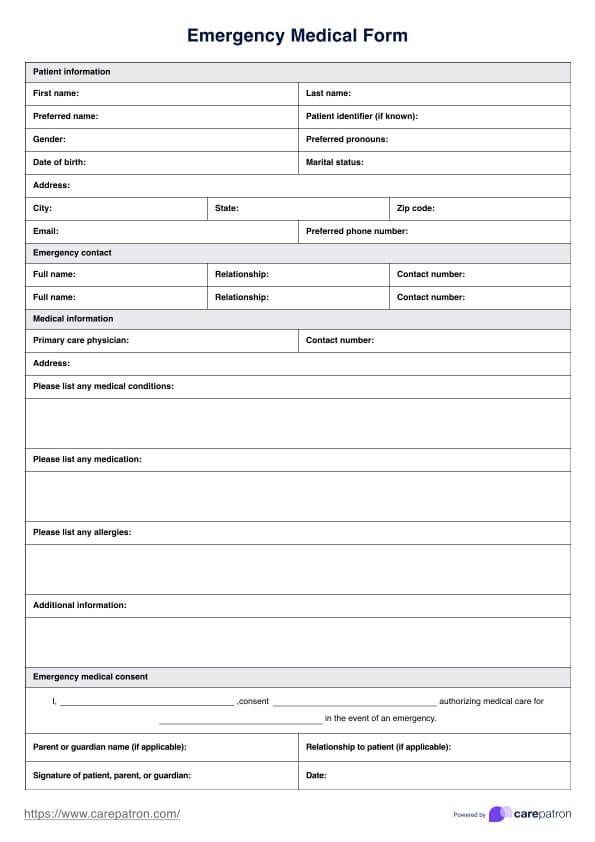Positive Allergy Skin Test Results Chart
Discover the comprehensive guide to Positive Allergy Skin Test Results Template & Example. Free PDF download for healthcare professionals.


What is a Positive Allergy Skin Test Results Template?
Allergy skin test is a standard procedure used to identify allergic sensitivities. In the dynamic world of healthcare, where precision and clarity are paramount, the Positive Allergy Skin Test Results Template emerges as an indispensable tool for professionals.
At its core, the template serves as a structured guide, enabling healthcare providers to record test results in a clear, concise, and standardized format. This is crucial in allergy testing, where the accurate interpretation of results can significantly impact patient care and treatment plans. The template typically includes sections for patient information, specific allergens tested, reaction measurements, and interpretative notes.
For healthcare professionals, this template isn't just about recording data; it's about enhancing patient communication and care. Using a standardized format ensures that all relevant information is captured systematically, reducing the likelihood of errors or omissions. This is particularly important in allergy care, where the nuances of a patient's reactions can guide critical decisions about their lifestyle and treatment options.
Incorporating this template into your practice is made effortless with practice management software from Carepatron. This software facilitates the efficient use of such templates and integrates them into a broader patient care management system. This integration allows seamless access to patient histories, test results, and treatment plans, all within a secure and user-friendly platform.
In summary, the Positive Allergy Skin Test Results Template is a vital resource for healthcare professionals, ensuring accurate, efficient, and comprehensive documentation of allergy test outcomes. Its use is a testament to the commitment to providing high-quality care in the ever-evolving healthcare field.
Positive Allergy Skin Test Results Chart Template
Positive Allergy Skin Test Results Chart Example
How to use the Positive Allergy Skin Test Results Template
The Positive Allergy Skin Test Results Template is a vital tool for healthcare professionals in accurately documenting and interpreting allergy test outcomes. Here's a step-by-step guide on how to use this template effectively:
Gather patient information
Start by filling in the patient's details, such as name, date of birth, gender, contact information, and the date of the allergy test. This information is crucial for patient identification and record-keeping.
Document medical history and related questions
Record known allergies, previous allergy tests, medications, and relevant medical conditions. Additionally, ask the patient about symptoms experienced, their duration, and any known triggering factors. This information provides context for interpreting the test results.
Conduct and record allergy skin test results
For each allergen tested, document the reaction size and description. Interpret each reaction, indicating positive, negative, or mildly positive. Include additional notes for each allergen, offering insights into the patient's allergic reactions.
Finalize with doctor's notes and signature
Conclude the report with any additional observations or recommendations. The attending healthcare professional should sign and date the template, validating the test results.
In conclusion, this template ensures a thorough and systematic approach to allergy skin testing, aiding in accurate diagnosis and patient care.
When would you use this form?
The Positive Allergy Skin Test Results Template is essential for various healthcare settings. Understanding when to use this form is crucial for effective patient care:
- Initial allergy screening: When a patient presents symptoms suggestive of an allergic reaction, this form documents and interprets the results of an allergy skin test.
- Routine check-ups for known allergies: For patients with a history of allergies, this template is helpful during regular follow-ups to monitor any changes in their allergic responses.
- Before prescribing medication: This form can rule out potential allergens in cases where a medication might trigger allergic reactions.
- Pediatric assessments: Instrumental in pediatric care for identifying allergies early in a child's life.
- Emergencies: In emergency settings, where a patient may be experiencing an unknown allergic reaction, this form helps quickly document and assess the allergens.
This template is versatile and applicable in various medical scenarios, from routine check-ups to emergencies, ensuring accurate allergy assessment and patient safety.
What do the results mean?
Interpreting the results of a skin allergy test is a critical component of patient care. The Positive Allergy Skin Test Results Template helps in understanding these outcomes:
- Positive reaction: A positive reaction (redness, swelling at the test site) indicates that the patient is likely allergic to the specific allergen tested. This requires further discussion on management and avoidance strategies.
- Negative reaction: No visible reaction suggests that the patient is not allergic to the tested substance, providing reassurance and guiding treatment decisions.
- Mildly positive reaction: A mild reaction may indicate a low-level sensitivity to the allergen. This requires careful monitoring and possibly further testing.
- Inconclusive Results: Sometimes, results may need to be clarified. In such cases, additional tests or alternative methods may be required for a definitive diagnosis.
Understanding these results is crucial for developing an effective management plan for the patient's allergies. The template aids healthcare professionals in making informed decisions based on the test outcomes, ensuring optimal patient care.
Research & evidence
The Positive Allergy Skin Test Results Template is grounded in a rich history of clinical research and evidence. Developing and refining allergy skin tests has been a cornerstone in diagnosing and managing allergic diseases. Here's a summary of the research and evidence supporting its use:
- Clinical efficacy of diagnostic tests: A study by Vanarsdel and Larson (1989) highlights the clinical efficacy of skin testing, emphasizing its effectiveness when based on patient history. The study compares the sensitivity and specificity of different skin testing methods, noting that skin prick testing is often sufficient to identify or exclude IgE-mediated hypersensitivity, including food allergies. This research underpins the template's focus on detailed patient history and specific test results.
- Advances in drug allergy diagnosis: Primeau and Adkinson (2001) discuss recent advancements in diagnosing drug allergies, including skin tests for penicillins and patch tests for delayed cutaneous reactions. This research supports the template's inclusion of various allergens, including drugs, in the testing process.
- Role of atopy patch test: Incorvaia and Fuiano (2015) review the diagnostic utility of the Atopy Patch Test (APT), especially for allergies caused by house dust mites. This study reinforces the template's comprehensive approach to testing various allergens, including environmental factors.
- Interpreting IgE sensitization tests in food allergy: Chokshi and Sicherer (2016) discuss using IgE serum tests in diagnosing food allergies, highlighting the importance of test selection and interpretation based on clinical history. This research aligns with the template's emphasis on correlating test results with patient symptoms and medical history.
References
Chokshi, N. Y., & Sicherer, S. (2016). Interpreting IgE sensitization tests in food allergy. Expert Review of Clinical Immunology, 12(4), 389-398.
Incorvaia, C., & Fuiano, N. (2015). The Role of the Atopy Patch Test in the Diagnosis of Allergy. Journal of Allergy & Therapy, 6(2).
Primeau, M., & Adkinson, N. (2001). Recent advances in the diagnosis of drug allergy. Current Opinion in Allergy and Clinical Immunology, 1(4), 337-341.
Vanarsdel, P., & Larson, E. (1989). Diagnostic tests for patients with suspected allergic disease. Utility and limitations. Annals of Internal Medicine, 110(4), 304-312.
Commonly asked questions
Positive Allergy Skin Test Results are highly accurate when performed correctly. They provide valuable insights into a patient's allergic sensitivities, guiding effective treatment plans.
While highly effective, these tests primarily identify IgE-mediated allergies. They may not detect non-IgE-mediated allergies, which might require different testing methods.
Allergy skin tests are generally safe but can occasionally cause mild reactions like redness or swelling at the test site. Severe reactions are rare.


